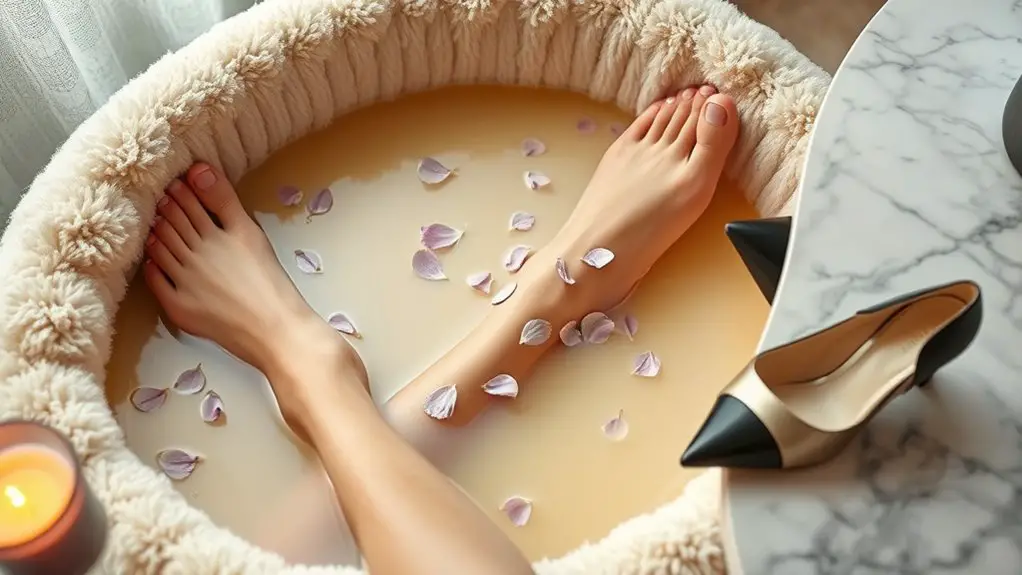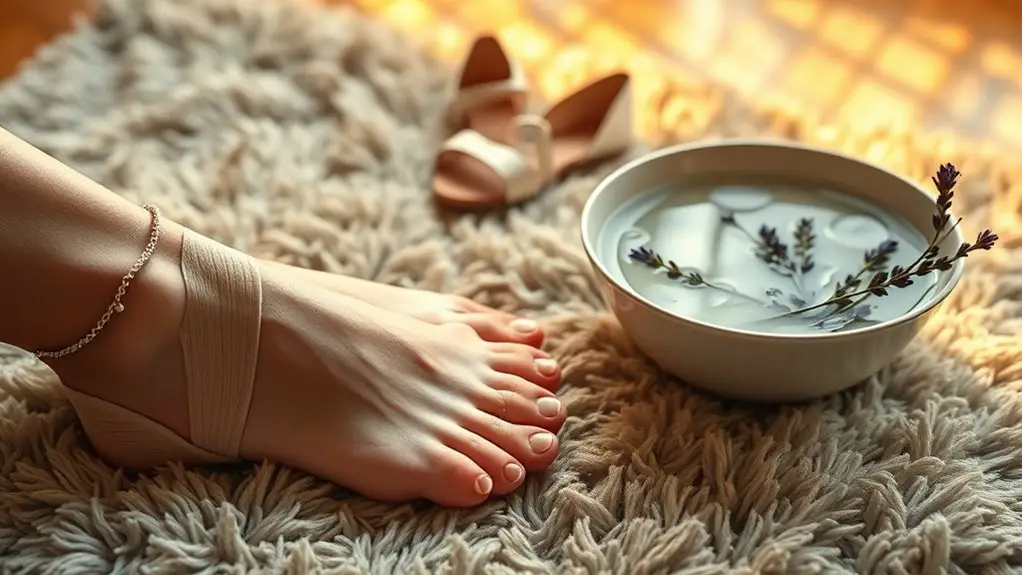To recover from sore feet after a day in heels, start with gentle stretching and foot exercises to relieve tension. Soaking your feet in warm water mixed with Epsom salt can provide instant relief. Choose supportive footwear and consider using ice and heat therapy to reduce inflammation. Elevate your feet for improved circulation, and make certain you stay hydrated and eat nutrient-rich foods to assist in recovery. There’s much more you can do to enhance your foot care routine.
Stretching Exercises to Relieve Tension

Have you ever noticed how simple stretches can make a world of difference for sore feet? Engaging in foot yoga can greatly alleviate discomfort caused by prolonged standing or wearing heels. Start with calf stretches; they’re essential for relieving tension in your lower legs and feet. Stand facing a wall, place your hands on it, and step one foot back, keeping it straight while bending the front knee. Hold this position for 15-30 seconds before switching sides.
Incorporating foot yoga into your routine also helps enhance flexibility and circulation. Try seated ankle circles or toe stretches, where you flex and point your toes to release tightness. These gentle movements not only alleviate pain but also improve overall foot health. Regularly practicing these stretches can lead to better posture and reduced soreness, allowing you to feel more comfortable and energized throughout your day.
Soothing Foot Soaks for Instant Relief
Soaking your feet can provide immediate relief from soreness and fatigue. Epsom salt is particularly beneficial, as it helps reduce inflammation and relaxes tired muscles. Additionally, incorporating herbal infusions can enhance the soothing effects, offering both comfort and therapeutic benefits.
Epsom Salt Benefits
Many people find relief from sore feet through the use of Epsom salt, a natural mineral compound known for its therapeutic properties. Epsom salt is rich in magnesium, which enhances magnesium absorption in your body, promoting relaxation and reducing pain. Here are some benefits of using Epsom salt for foot soaks:
- Reduces Inflammation: Helps soothe swollen feet after a long day.
- Relieves Muscle Tension: Eases tightness in foot muscles, promoting comfort.
- Improves Circulation: Encourages blood flow, which aids recovery.
- Enhances Relaxation: The soothing nature promotes mental and physical calmness.
Incorporating Epsom salt into your foot care routine can make a significant difference in your recovery from sore feet.
Herbal Infusion Options
While Epsom salt is a popular choice for foot relief, herbal infusions can offer additional soothing benefits that enhance your recovery experience. Consider creating a calming foot soak using herbal blends like chamomile, lavender, or peppermint. These herbs possess natural calming properties that can help alleviate soreness and reduce inflammation. To prepare, steep your chosen herbs in hot water for 10-15 minutes, strain, and add the infusion to a basin of warm water. Soak your feet for 15-20 minutes, allowing the herbal compounds to penetrate your skin. This simple ritual not only relaxes your feet but also promotes overall well-being. Incorporating herbal infusions into your recovery routine can transform your foot care experience into a rejuvenating ritual.
Importance of Proper Footwear Choices

Choosing the right footwear is essential for maintaining foot health, especially if you find yourself on your feet for extended periods. Proper footwear choices can greatly impact your comfort and well-being, particularly when it comes to heel height and footwear materials. Here are four key factors to take into account:
- Heel Height: Opt for lower heels whenever possible to reduce strain on your feet and legs.
- Arch Support: Look for shoes with adequate arch support to help distribute weight evenly.
- Footwear Materials: Choose breathable materials that allow for air circulation, minimizing moisture and discomfort.
- Fit: Verify your shoes fit well; a snug but comfortable fit can prevent blisters and other foot ailments.
Utilizing Ice and Heat Therapy
When your feet are sore, utilizing ice and heat therapy can provide significant relief. Ice therapy helps reduce inflammation and numb pain, while heat promotes blood flow and relaxes tight muscles. Alternating between these treatments can optimize your recovery process and enhance your comfort.
Benefits of Ice Therapy
Ice therapy can be an effective way to alleviate sore feet, as it reduces inflammation and numbs pain. By utilizing ice application or cold compresses, you’ll find relief and promote recovery. Here are some benefits you can expect:
- Reduced Swelling: Ice helps constrict blood vessels, minimizing swelling after a long day in heels.
- Pain Relief: The numbing effect of ice can temporarily relieve sharp or throbbing pain.
- Enhanced Recovery: Regular ice therapy can speed up recovery time, allowing you to get back on your feet sooner.
- Improved Circulation: Alternating ice with gentle movement can stimulate blood flow, aiding in recovery.
Incorporating ice therapy into your routine can greatly enhance your comfort and well-being.
Applying Heat Effectively
Applying heat effectively can be just as important as ice therapy in managing sore feet, especially when you’re dealing with muscle tension or stiffness. Utilizing various heat application techniques, like heating pads or warm baths, can provide significant relief. The benefits of warmth include improved blood circulation, which enhances healing and promotes relaxation.
| Technique | Benefits | Duration |
|---|---|---|
| Heating Pad | Reduces muscle tension | 15-20 minutes |
| Warm Foot Bath | Soothes aches | 20-30 minutes |
| Warm Towel Wrap | Increases circulation | 10-15 minutes |
| Hot Stone Massage | Eases stiffness | 30-60 minutes |
Remember to monitor the heat level to avoid burns. Consistent use can lead to a more comfortable recovery.
Alternating Between Treatments
To effectively manage sore feet, alternating between ice and heat therapy can provide ideal relief by addressing both inflammation and muscle tension. This method is essential for thorough foot care, especially if you’re dealing with heel pain.
- Ice Therapy: Apply an ice pack for 15-20 minutes to reduce swelling and numb pain.
- Heat Therapy: Follow with a warm compress or heating pad for 15-20 minutes to relax tight muscles.
- Repeat: Alternate between ice and heat every few hours for maximum benefit.
- Rest: Don’t forget to elevate your feet during treatment to enhance circulation.
Incorporating this simple routine into your recovery can make a significant difference, helping you feel more comfortable and rejuvenated.
Massage Techniques for Sore Feet
A soothing massage can be a highly effective way to alleviate sore feet and promote relaxation. Utilizing reflexology techniques can help target specific pressure points in your feet, releasing tension and improving circulation. Here are some simple methods you can try:
| Technique | Description |
|---|---|
| Thumb Walking | Use your thumbs to walk along the sole, applying gentle pressure. |
| Pinching Technique | Pinch the skin between your toes gently, focusing on the base. |
| Circular Motions | Use your fingers to make circular motions on the arch and heel. |
Elevating Your Feet for Better Circulation

After enjoying a massage, elevating your feet can further enhance circulation and reduce soreness. Foot elevation is a simple yet effective practice that promotes circulation improvement, helping your feet recover from the strain of heels. Here are four easy ways to elevate your feet:
- Use a Pillow: Place a soft pillow under your feet while lying down to raise them above heart level.
- Wall Support: Lie on your back and prop your legs up against a wall. This position assists in blood flow.
- Reclining Chair: If you have a recliner, lean it back to elevate your feet comfortably.
- Foot Rest: While sitting, use a footrest or stack of books to keep your feet elevated.
Incorporating these methods for foot elevation can greatly aid in circulation improvement, allowing you to feel more comfortable after a long day in heels.
Hydration and Nutrition for Foot Health
While many focus on external treatments for sore feet, proper hydration and nutrition play an essential role in maintaining foot health. Staying hydrated helps reduce swelling and keeps your muscles functioning effectively. Aim for at least eight glasses of water daily, and consider incorporating these hydration sources:
| Hydration Sources | Nutrient-Rich Foods | Benefits |
|---|---|---|
| Water | Spinach | Rich in magnesium |
| Coconut Water | Blueberries | High in antioxidants |
| Herbal Teas | Quinoa | Contains essential protein |
| Fruits (e.g., watermelon) | Almonds | Loaded with healthy fats |
| Vegetable Juices | Sweet Potatoes | Excellent source of fiber |
In addition to hydration, consuming nutrient-rich foods can provide your feet with the necessary vitamins and minerals for recovery. A balanced diet supports overall health, ensuring your feet stay strong and pain-free.
Preventative Measures for Future Comfort
To guarantee your feet remain comfortable and pain-free in the future, it’s crucial to adopt preventative measures that address both lifestyle choices and footwear. Here are four essential tips to contemplate:
- Choose the Right Footwear Materials: Opt for shoes made from breathable and flexible materials that allow for natural foot movement. This can reduce discomfort considerably.
- Mind Your Heel Height: Select heels that are no more than 2-3 inches high. Lower heels distribute weight more evenly and lessen stress on your feet.
- Incorporate Foot Exercises: Regularly perform stretches and strengthening exercises for your feet and calves to enhance flexibility and prevent injuries.
- Use Orthotic Inserts: Think about investing in quality orthotic insoles tailored to your foot’s unique shape, providing additional support and cushioning.
Frequently Asked Questions
How Long Should I Rest My Feet After Wearing Heels?
After wearing heels, it’s best to rest your feet for at least 30 minutes. Elevate them and incorporate gentle stretching to relieve tension. This will help reduce discomfort and promote recovery effectively.
Can I Use Essential Oils for Foot Pain Relief?
Yes, you can use essential oils for foot pain relief. Their anti-inflammatory properties can enhance foot massage effectiveness, providing essential oil benefits that promote relaxation and improve circulation, helping you recover from discomfort more efficiently.
What Are the Best Types of Insoles for Heels?
You’d think all insoles are created equal, but they’re not. For heels, look for ones with excellent arch support and gel cushioning. They’ll help ease discomfort while still letting you strut your stuff confidently.
Are There Specific Brands Known for Comfortable Heels?
When searching for comfortable heel brands, consider those with cushioned insoles, arch support, and wider toe boxes. Brands like Clarks and Naturalizer specialize in heel design features that prioritize comfort without sacrificing style.
When Should I See a Doctor for Foot Pain?
If your foot pain persists beyond a few days, worsens, or is accompanied by swelling, numbness, or difficulty walking, it’s time to consult a doctor. They can assess causes and recommend appropriate treatment options.



